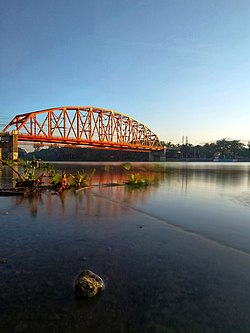| Agusan River Rio Grande de Agusan | |
|---|---|
 The Agusan River and Magsaysay Bridge in 2019 | |
 Agusan River drainage basin | |
Agusan River mouth | |
| Location | |
| Country | Philippines |
| Region | |
| Province | Agusan del Sur |
| Cities/municipalities | |
| Physical characteristics | |
| Source | Mount Tagubud, Pantukan, Davao de Oro |
| • location | Davao del Norte |
| • coordinates | 7°26′35″N126°13′16″E / 7.443°N 126.221°E |
| • elevation | 1,022 m (3,353 ft) |
| Mouth | Butuan Bay |
• location | Butuan |
• coordinates | 9°01′00″N125°30′40″E / 9.01667°N 125.51111°E |
• elevation | 0 m (0 ft) |
| Length | 349 km (217 mi) [1] |
| Basin size | 11,937 km2 (4,609 sq mi) [2] |
| Basin features | |
| Tributaries | |
| • left | |
| • right | |
The Agusan River is third longest river in the Philippines, located in the north-eastern part of Mindanao island, draining majority of the Caraga region and some parts of Davao de Oro. It is the country's third largest river (after the Cagayan River and Rio Grande de Mindanao) with a total drainage area of 11,937 square kilometres (4,609 sq mi) [2] and an estimated length of 349 kilometres (217 mi) from its origin. [1] [3] [4]

